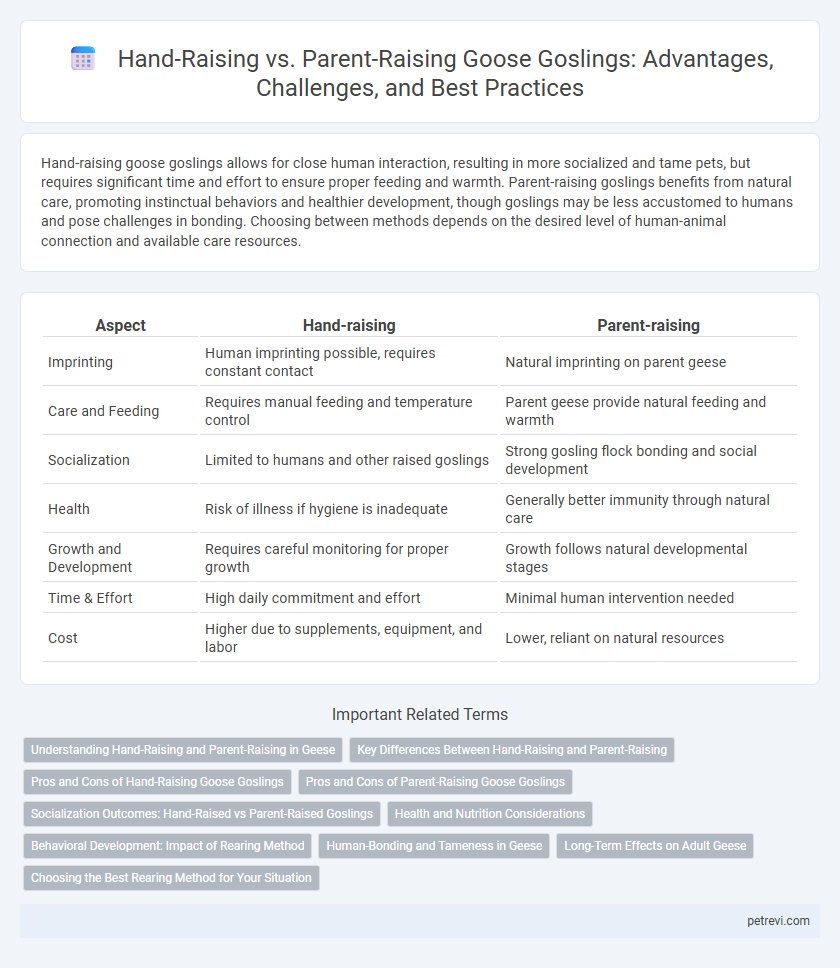Hand-raising goose goslings allows for close human interaction, resulting in more socialized and tame pets, but requires significant time and effort to ensure proper feeding and warmth. Parent-raising goslings benefits from natural care, promoting instinctual behaviors and healthier development, though goslings may be less accustomed to humans and pose challenges in bonding. Choosing between methods depends on the desired level of human-animal connection and available care resources.
Table of Comparison
| Aspect | Hand-raising | Parent-raising |
|---|---|---|
| Imprinting | Human imprinting possible, requires constant contact | Natural imprinting on parent geese |
| Care and Feeding | Requires manual feeding and temperature control | Parent geese provide natural feeding and warmth |
| Socialization | Limited to humans and other raised goslings | Strong gosling flock bonding and social development |
| Health | Risk of illness if hygiene is inadequate | Generally better immunity through natural care |
| Growth and Development | Requires careful monitoring for proper growth | Growth follows natural developmental stages |
| Time & Effort | High daily commitment and effort | Minimal human intervention needed |
| Cost | Higher due to supplements, equipment, and labor | Lower, reliant on natural resources |
Understanding Hand-Raising and Parent-Raising in Geese
Hand-raising goose goslings involves human intervention from birth, providing consistent warmth, feeding, and socialization to ensure proper growth and tameness. Parent-raising allows goslings to develop natural behaviors and instincts under the care of their goose parents, promoting strong survival skills and social bonding. Understanding the benefits and challenges of each method helps optimize gosling development, balancing human interaction with natural upbringing.
Key Differences Between Hand-Raising and Parent-Raising
Hand-raising goslings involves human intervention in feeding, warmth, and protection, ensuring controlled nutrition and immediate care, while parent-raising relies on natural behaviors where adult geese provide nourishment, grooming, and safety within their natural habitat. Hand-raised goslings may develop stronger bonds with humans and potentially experience different socialization patterns compared to parent-raised goslings that acquire essential survival skills and natural instincts from their parents. The key differences lie in dependency levels, social development, and exposure to natural environmental stimuli crucial for gosling growth and adaptation.
Pros and Cons of Hand-Raising Goose Goslings
Hand-raising goose goslings allows for controlled nutrition and early socialization with humans, promoting tame and friendly behavior, but it requires significant time, effort, and appropriate temperature management to prevent health issues like respiratory infections. Parent-raised goslings develop natural behaviors and immunity by learning from their parents, yet they may become more wary of humans and harder to handle. Choosing hand-raising can enhance gosling survival in orphaned or abandoned cases but demands a consistent feeding schedule and proper hygiene to avoid diseases such as bumblefoot.
Pros and Cons of Parent-Raising Goose Goslings
Parent-raising goose goslings promotes natural behavior development, social bonding, and survival skills essential for wild environments. However, it carries risks such as higher mortality rates due to predation, disease exposure, and inconsistent parental care. Despite these challenges, parent-raised goslings tend to exhibit stronger adaptation abilities and more robust immune systems than hand-raised counterparts.
Socialization Outcomes: Hand-Raised vs Parent-Raised Goslings
Hand-raised goslings typically develop stronger bonds with humans and exhibit greater socialization with people, enhancing their tame and approachable behavior. In contrast, parent-raised goslings learn natural behaviors and social cues essential for integration within goose flocks, resulting in more typical species-specific social skills. Studies indicate hand-raising can lead to increased human dependency, while parent-raising favors natural autonomy and flock cohesion.
Health and Nutrition Considerations
Hand-raising goose goslings allows for precise control over their diet, ensuring they receive balanced nutrition tailored to their developmental needs, which can reduce the risk of malnutrition and disease. Parent-raised goslings benefit from natural feeding behaviors, obtaining instinctual nutrients through their mother's care and foraging guidance, which supports robust immune system development. Monitoring health in hand-raised goslings requires diligent supplementation of vitamins and minerals to mimic the natural diet provided by parent geese and prevent growth deficiencies.
Behavioral Development: Impact of Rearing Method
Hand-raising goose goslings often results in stronger human imprinting, leading to increased tameness and socialization with people, but can limit natural behaviors such as foraging and predator awareness. Parent-raised goslings typically develop essential survival skills and social structures through interaction with adult geese, enhancing their ability to communicate and respond to environmental stimuli effectively. The rearing method significantly influences the goslings' behavioral repertoire, with hand-reared birds requiring more guidance for natural instincts compared to those nurtured by their parents.
Human-Bonding and Tameness in Geese
Hand-raising goose goslings fosters strong human-bonding and increases tameness, as the birds imprint on their caregivers and exhibit trust and familiarity toward humans. Parent-raised goslings develop natural behaviors but tend to be more cautious and less comfortable around people, limiting opportunities for close interaction. For those seeking affectionate, approachable geese, hand-raising enhances socialization and promotes gentle, calm adult geese accustomed to human presence.
Long-Term Effects on Adult Geese
Hand-raising goose goslings often results in stronger human imprinting, leading to increased tameness but potential social integration challenges within wild flocks. Parent-raised goslings develop natural behaviors and social bonds crucial for survival, enhancing their adaptability and mating success as adults. Studies indicate goslings reared by parents exhibit better long-term fitness and reproductive outcomes compared to hand-raised counterparts.
Choosing the Best Rearing Method for Your Situation
Hand-raising goose goslings offers precise control over diet, health monitoring, and socialization, essential for urban or small-scale settings with limited adult geese. Parent-raising allows goslings to develop natural behaviors, social structure, and foraging skills within a flock, ideal for rural or large outdoor environments where adult geese are present. Assess factors such as available time, environment, and long-term goals to determine whether hand-raising or parent-raising best suits your specific geese rearing situation.
Hand-raising vs Parent-raising for Goose goslings Infographic

 petrevi.com
petrevi.com